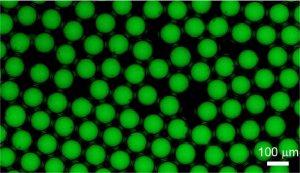Charge‐Selectively Permeable Self‐Healing Microcapsules
Microcapsules with selectively permeable shells are attractive delivery vehicles, containers for sensing, and micro-reactions. While capsules exhibiting a size-selective permeability have been frequently reported, those possessing a charge-selective permeability are much rarer. In this study, we present a new type of capsule endowed with viscoelastic shells that display a charge-selective permeability. The capsules are composed of a thin, viscoelastic shell made of surfactants that are functionalized with a chelator, 3-hydroxy-4-pyridinonone (HOPO). These chelator-functionalized surfactants can be reversibly crosslinked with appropriate nm-sized ion clusters, such as Fe3+/Tris or Al3+/Tris. We demonstrate that these capsules can repeatedly uptake and release selected reagents. We thus foresee these capsules to be useful, for example, for wastewater treatment, or as picoliter-sized reaction vessels that enable performing selected chemical processes within their cores. This work was published in Advanced Materials Interfaces.
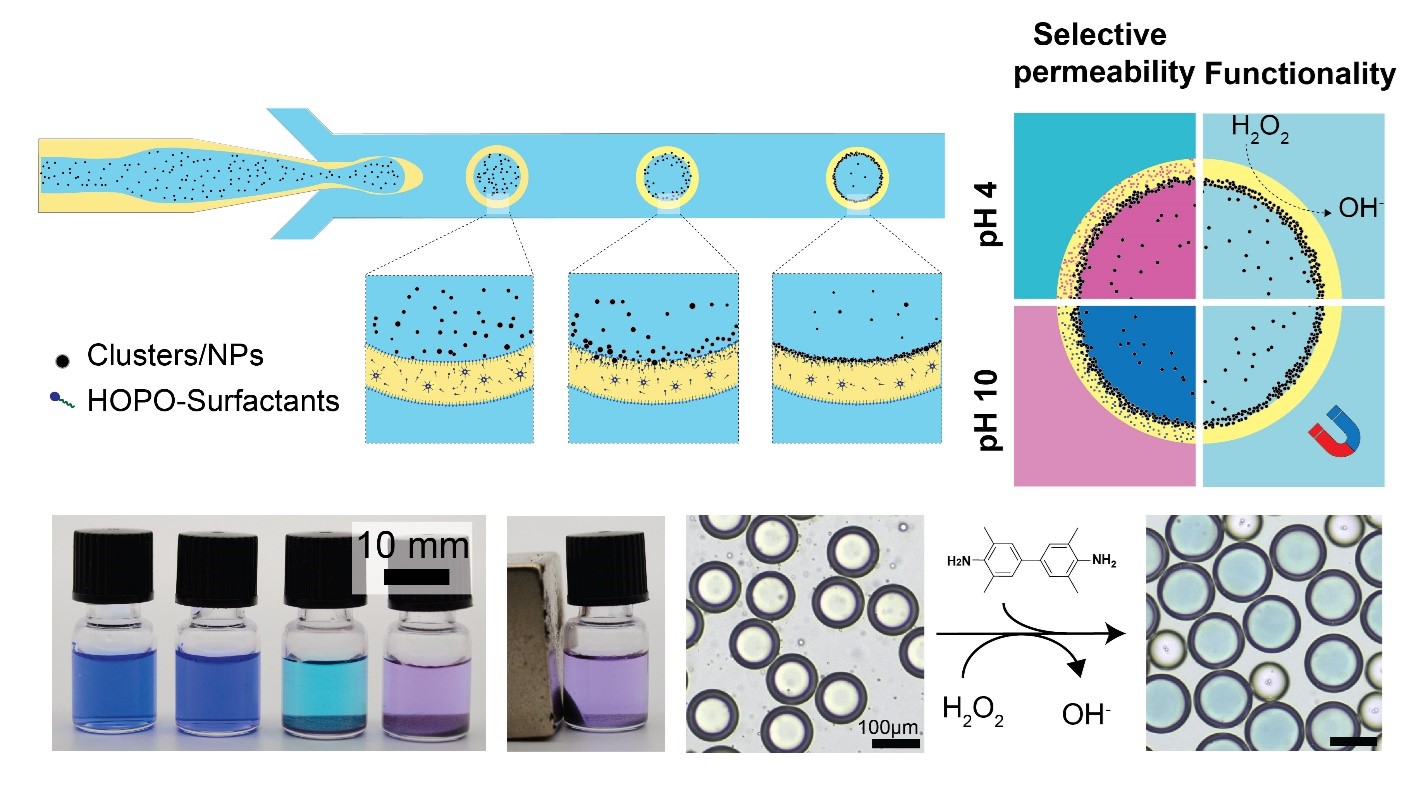
Rheological Properties of Ionically Crosslinked Viscoelastic 2D Films VS Corresponding 3D Bulk Hydrogels
Ionically crosslinked hydrogels gained a lot of attention especially for underwater applications due to their self-healing and adhesive properties. However, little is known about thin viscoelastic membranes encompassing similar chelator-ion pair motifs, despite their potential for capsule shells, adhesives, or drug delivery. We recently demonstrated the feasibility of creating 10 nm thick viscoelastic membranes from catechol-functionalized surfactants that have been ionically crosslinked at liquid/liquid interfaces. Here, we demonstrated that the vast knowledge about the influence of the chelator-ion pair on the mechanical properties of ionically crosslinked 3D hydrogels can be applied to 2D systems. We compared the dynamic mechanical properties of pyrogallol-functionalized 3D hydrogels with those of thin, viscoelastic membranes that have been crosslinked with the same chelator-ion pairs. We demonstrate that as the ion-chelator affinity increases, the storage and loss moduli of viscoelastic membranes increase, by analogy to the behavior of bulk hydrogels. Yet the relaxation times of thin viscoelastic membranes are much faster than that of bulk hydrogels that have been crosslinked with identical chelator-ion pairs. This insight enables the design of tunable viscoelastic, adhesive, self-healing membranes. This work was published in ACS Applied Materials & Interfaces.
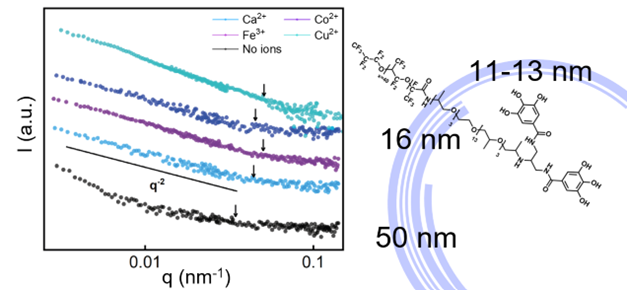
From Surfactants to Viscoelastic Capsules
Micrometre-sized capsules find widespread use for example in food, cosmetics, and drug delivery, for encapsulating and releasing active ingredients. The stability and controlled release of these capsules depend on shell dimensions and composition. Traditional capsules are often thick or rigid, making them fragile. This study presents a novel type of capsule with 10 nm thin, yet viscoelastic and self-healing, shells. These shells, created through ionic crosslinking of catechol-derivatives functionalized surfactants, are impermeable to substances as small as 340 Da. The research explores the influence of numbers of chelators per surfactant and the type of crosslinking ion used to reversibly connect them at the drop surface on the rheological properties of the resulting membranes. We relate this parameter to the capsule stability and demonstrate their stability under physiologic conditions, indicating their potential for biomedical applications. This work was published in Advanced Materials Interfaces.

High throughput production of size-selective, hydrogel-based capsules
Microcapsules with liquid cores are often employed to transport biological or chemical cargo, precisely time its release or protect it from the surrounding environment. Emulsion drops present ideal templates to produce microcapsules of defined sizes and compositions. If these emulsion templates are produced with microfluidics the resulting capsules are highly uniform with tuneable diameters typically varying between 10 and a few 100 µm.
The most common way to produce calibrated capsules with liquid cores is the use of double emulsions as templates. However, the production of double emulsions is labor intense and the throughput low. To overcome these limitations, we introduced a robust, scalable method to produce microcapsules possessing a thin hydrogel shell from water-in-oil single emulsion templates. We demonstrate that the porous hydrogel shell is permeable for small molecules but impermeable for larger ones. We take advantage of this property to grow living cells such as bacteria and yeast under confinement as the cells are trapped within the capsules and nutrients and waste products are readily exchanged with the surrounding. We demonstrate an additional asset of these capsules possessing a size-selective permeability: Their use to efficiently remove pollutants from waste water. The fast and robust fabrication of the hydrogel microcapsules enables their use in a wide range of applications including for drug screening, encapsulation of probiotics and other cells, waste water cleaning or as micro reactors [M. Steinacher et al., 2021].
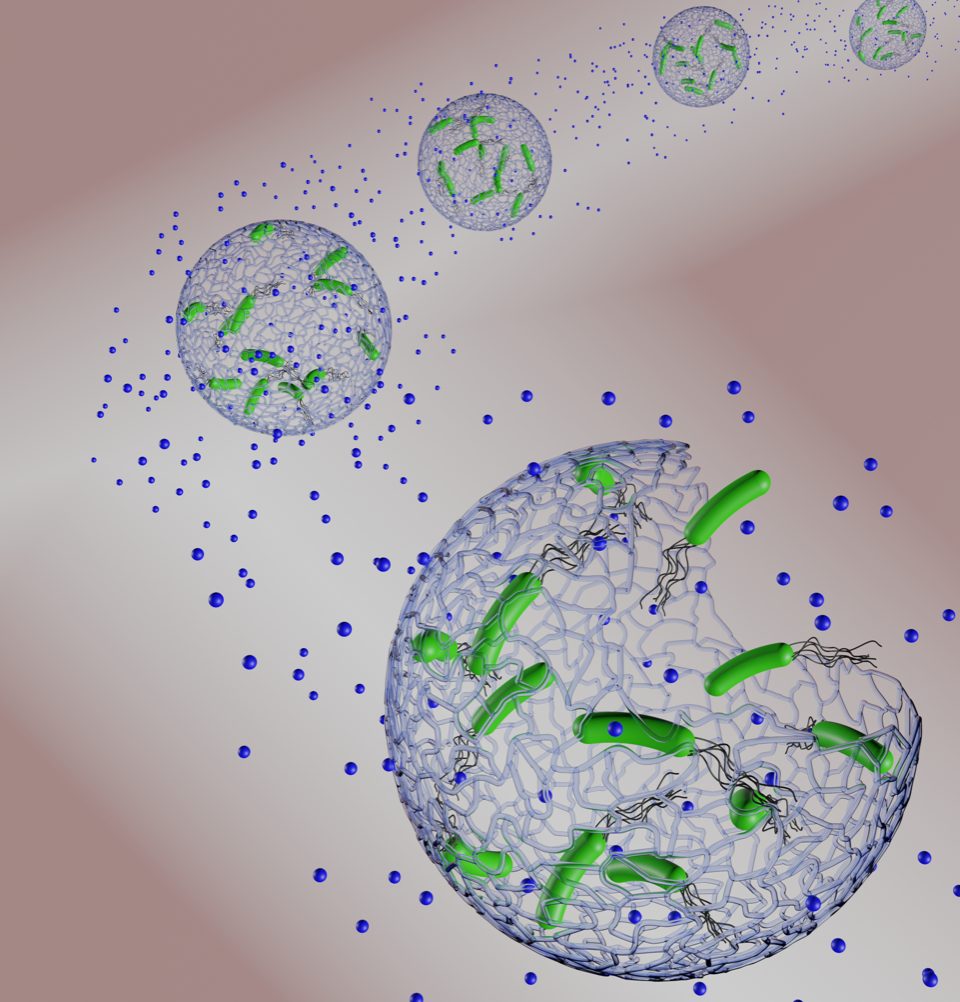
Production of Viscoelastic Capsules and Their Assembly into Granular Scaffolds
We introduced catechol-functionalized block-copolymer-based surfactants that efficiently stabilize water-in-oil emulsions and enable their conversion into viscoelastic capsules. This is achieved by ionically crosslinking surfactants located in close proximity to the drop surface. We demonstrated that the ionic crosslinking of the surfactants at the drop surface prevents the uncontrolled transport of hydrophilic reagents across oil phases that is otherwise observed. Hence, they open up new opportunities to use these drops as closed containers for example for sensitive high throughput screening assays. Importantly, these capsules cannot only be used as individually dispersed containers but we demonstrated that they can be collectively used to form granular scaffolds possessing well-defined microstructures. Hence, they open up a new field of use of capsules: as building blocks for 3D printed microstructured polymeric scaffolds.
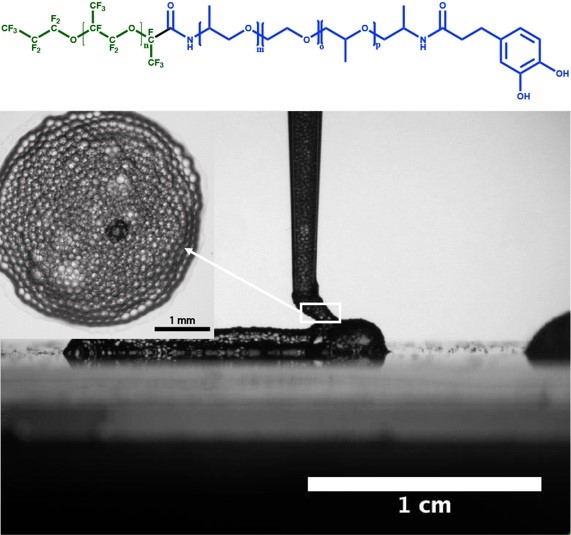
Stabilization of emulsion drops
Most emulsion drops with diameters above a few µm are metastable and tend to coalesce to minimize the liquid-liquid interface area. To avoid coalescence, drops are often stabilized with surfactants. However, even if stabilized with surfactants, drops are prone to coalescence if stored at high densities, high temperatures, or if they are in contact with solutions containing high salt concentrations. This prevents us from using drops as templates to build more macroscopic materials with well-defined structures and locally varying composition. To overcome this difficulty, we are studying how the structure and composition of block-copolymer surfactants influences the stability of emulsion drops. In particular, we compare the ability of perfluorinated di- and triblock copolymers to impart stability to emulsion drops even if they are stored at a high density or exposed to elevated temperatures. Moreover, we explore different possibilities to use surfactants to introduce functionalities to the surfaces of emulsion drops [G. Etienne et al, 2016].
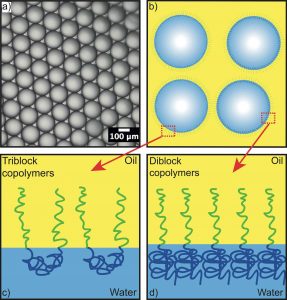
Leakage from drops
Emulsion drops are often used as picoliter-sized reaction vessels to conduct screening assays or to perform chemical and biochemical reactions by consuming only minimal reagent volumes. In these applications, it is typically assumed that reagents, whose solubility in the surrounding oil phase is very low, are not transported across the oil phase such that no cross-contamination between different drops occurs. However, recent reports by our group, along with others in this field revealed appreciable transport of aqueous solutes across fluorinated oil phases. Such transports appear to defy the basic principles of solubility of compounds, while the term “immiscible” phases certainly appears more elusive than previously imagined. Our group seeks to understand the underlying mechanism influencing the transport of small molecules across fluorinated oils. Using this deeper understanding of transport mechanism, we are developing strategies to control this transport or to completely suppress it [G. Etienne et al, 2018].
Selectively permeable double emulsions
Double emulsions are often used as closed containers to conduct chemical and biochemical reactions in picoliter volumes, to screen substances at high throughputs, or as templates to fabricate capsules. These applications require a tight control over the transport of reagents across the double emulsion shells. In most cases, double emulsions are considered to be impermeable towards encapsulants that have a low solubility in the shell. Our group demonstrated that hydrophilic substances that have a very low solubility in the oil shell of water-oil-water double emulsions are readily transported across their shells. We found that this transport is caused by small aqueous drops that form in the oil shell and carry reagents across it.
Our group developed a strategy to take advantage of these small aqueous drops: we synthesized a pH-sensitive catechol-functionalized block-copolymer surfactant that introduces a selective permeability to the double emulsion shells. We demonstrated that double emulsions stabilized with this surfactants are selectively permeable towards reagents that are electrostatically attracted by this surfactant. We leveraged this selective permeability to initiate complexation and crystallization reactions exclusively within double emulsion cores with a high temporal control [I. L. H. Ong, 2019].
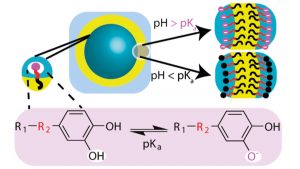
Fabrication of double emulsions with sub-µm thick shells
Double emulsions are composed of small drops contained in larger drops. They can be used to conduct chemical or biochemical reactions in them and as templates to produce capsules. Key to a successful application of these double emulsion drops is a good stability against coalescence and rupture. Previous studies have shown that the mechanical stability of double emulsions significantly increases if their shell is reduced below the µm length scale. Unfortunately, the fabrication of double emulsion drops with such thin shells at high throughputs is still challenging. We developed new microfluidic devices that enable reducing the thickness of double emulsion shells down to 250 nm, thereby making them more stable against coalescence and rupture. These double emulsions can be used as templates to fabricate mechanically robust capsules with thin, homogeneous shells that offer close control over the release of reagents.[A. Vian et al, 2016] [A. Vian et al, 2018]
